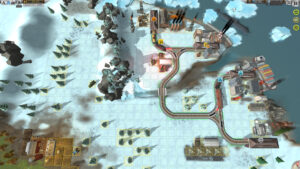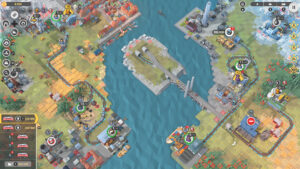Train Valley Revisited
When I started this blog, I posted about every game I played. That hasn’t been the case for a long time, and some games that have eaten large portions of my life have gone completely unremarked on. I did make a solitary post about Train Valley 2 a few years back, but this does not even begin to cover my experiences with it.
To recap a little: In contrast to the original Train Valley, which is a scramble to meet unpredictable demands (a bit like Mini Metro, but with completely different mechanics), Train Valley 2 is about making a plan and then executing that plan. It’s essentially a crafting game, where the crafting is mediated by trains: a city might need, say, dozen Copper Ingots, which are made at that factory over there out of Copper Ore and Coal, each of which is produced at a mine somewhere else on the map using Workers. (Workers are, like everything else, a consumable resource.) You have multiple demands to meet within a time limit 1That is, there isn’t a time limit per se. You can exceed the par time and still meet all your other goals. But only if you’re willing to settle for fewer than five stars., and thus have to prioritize, sending your trains where they’re most needed.
I think I found this structure most appealing at times when I felt blocked in other areas of my life. If I can’t make progress in my real plans, at least I can make a plan and execute it in Train Valley. The fact that it really does involve making a plan is important, I think. So many modern games tell you outright what you need to do at every moment, but TV2 just delivers a bunch of requirements and constraints and lets you figure out what needs to be done. The result is something that I found extremely compelling, to a perhaps unhealthy degree, downloading and playing user-made levels well past the point of enjoyment. I’ve uninstalled it several times, but then they’d come out with a new DLC pack2One of the DLC packs adds back the random passenger trains from the original Train Valley, letting people mix together the two play styles in a single level. My reaction to this is usually annoyance and a desire to get through the random stuff as quickly as possible so it stops interfering with the execution of my plans. and I’d begin the cycle anew.
Last year, an ad on the TV2 main menu announced the release of a third Train Valley game, Train Valley World. Despite a title containing a word suggestive of MMOs, this game turns out to still be essentially about levels playable by a single player. It does add multiplayer modes, but this is of not much use to me, as I don’t know anyone else interested in these games. It changes up the presentation and feel once more, basically going for something more like Civilization VI: levels are larger still than TV2, the graphics are finer and typically viewed at a greater distance, and, as in Civ, the cities all have names this time, these names being the names of real cities, even though the geography they’re placed in is nothing like reality. The tracks follow the same tile system as always, but the larger scale makes this fade in relevance. Instead of placing a route by dragging over every tile you want it to go through, you usually just click on a series of waypoints.
But the largest change to the feel of the thing is in how you give orders to trains. In the previous games, you send trains on single missions. You’d select a source of freight and a destination to bring it to, and a train would do that once, and then it would be done. If you wanted to send four trainloads of lumber to a sawmill, you’d give that order four times, perhaps using all of your trains in a convoy to send it all the lumber it will ever need at once. In TVW, you program a route into a train, potentially including multiple stops where it drops off one freight and picks up another, and then that train repeats that route until given new orders. Or attempts to, anyway; sometimes it can’t, like if a source of freight is empty, or a destination is full and can’t take any more. The overall gameplay, then, becomes less dominated by goals. It still has goals similar to TV2, with cities having specific demands, but you reach those goals by creating stable, balanced systems than can keep running indefinitely without your attention.
And for whatever reason, I find this a great deal less compelling than the get-it-done-and-then-stop approach of TV2. Perhaps it’s because it suggests endless labor, even if I’m not the one performing that labor. I’ve played through the TVW campaign, but I don’t feel drawn back to it. I’m hoping this breaks my Train Valley habit for good.
| ↑1 | That is, there isn’t a time limit per se. You can exceed the par time and still meet all your other goals. But only if you’re willing to settle for fewer than five stars. |
|---|---|
| ↑2 | One of the DLC packs adds back the random passenger trains from the original Train Valley, letting people mix together the two play styles in a single level. My reaction to this is usually annoyance and a desire to get through the random stuff as quickly as possible so it stops interfering with the execution of my plans. |
 Comments(0)
Comments(0)
